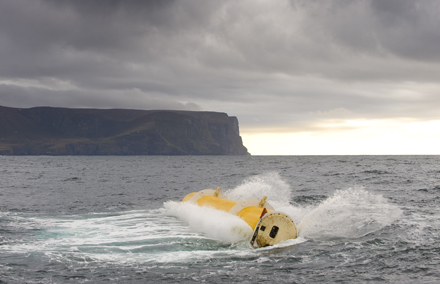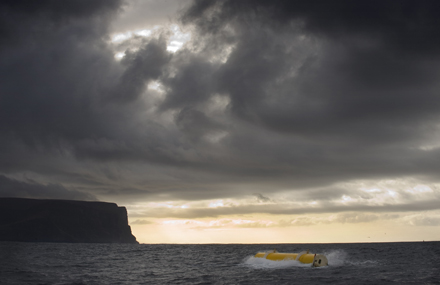Navigation
Hydro-electric Wave Energy Device “Oyster” Launched Off the Coast of Scotland
Scotland's potential renewables capacity is estimated to be around 60GW. Our waters hold around ten per cent of Europe’s wave power potential and as much as a quarter of its tidal power potential. The European Marine Energy Centre (EMEC) provides world-leading test facilities for Aquamarine and other companies to develop the technology needed to harness this huge untapped potential.
 |
| Oyster in operation at the Billia Croo Site near Stromness, Orkney The Oyster system consists of a hinged flap connected to the seabed at around 10m depth. Each passing wave moves the flap which drives a hydraulic piston to deliver high pressure water to an onshore turbine which generates electricity. The marine energy industry could provide as many as 12,500 jobs, contributing £2.5 billion to the UK economy by 2020. Marine energy has the potential to meet up to 20% of the UK’s energy demands. Photograph Courtesy Aquamarine Power |
The wave energy industry took a major stride forward on 20 November 2009 when the hydro-electric wave energy device, known as ‘Oyster,’ was officially launched by Scotland’s First Minister Alex Salmond MP, MSP at the European Marine Energy Centre (EMEC) in Orkney. The device, developed by wave energy company Aquamarine Power, is currently the world’s only hydro-electric wave energy device which is producing power.
The Oyster launch took place at EMEC’s Billia Croo site near Stromness, where the device was installed this summer. Scotland’s First Minister was on site to switch on Oyster for the first time.
Oyster is now producing power by pumping high pressure water to its onshore hydro-electric turbine. This will be fed into the National Grid to power homes in Orkney and beyond. A farm of 20 Oysters would provide enough energy to power 9,000 three bedroom family homes.
Oyster is Aquamarine Power’s first demonstration-scale wave energy device. Its performance will now be monitored and the results from the testing will provide a basis for the design of the next-generation commercial-scale Oyster.
Oyster is designed to capture the energy found in nearshore waves in water depths between 10 and 16 metres. The benefit of Oyster is its simplicity. There are minimal moving parts and all electrical components are onshore, making it robust enough to withstand the rigours of Scotland’s harsh seas.
Aquamarine Power has received significant funding and support from Scottish Enterprise, Highlands and Islands Enterprise, the Technology Strategy Board, the Royal Academy of Engineering, the Engineering and Physical Sciences Research Council (EPSRC) and the Scottish Government.
 |
| Oyster in operation at the Billia Croo Site near Stromness, Orkney Aquamarine Power’s specialist technical advisors include wave energy pioneers Professor Trevor Whittaker, head of the award-winning wave power research group at Queen’s University, Belfast, and Professor Stephen Salter, creator of the ‘Salter Duck’.Photograph Courtesy Aquamarine Power |
Speaking at the launch, Scotland’s First Minister Alex Salmond MP, MSP said, “I’m delighted to see first-hand the full-scale Oyster now installed and operating offshore. This is a key milestone for Aquamarine Power and for Scotland’s marine renewables sector.
“Scotland's potential renewables capacity is estimated to be around 60GW. Our waters hold around ten per cent of Europe’s wave power potential and as much as a quarter of its tidal power potential. The European Marine Energy Centre (EMEC) provides world-leading test facilities for Aquamarine and other companies to develop the technology needed to harness this huge untapped potential.
“I am delighted to confirm further R&D funding of almost £1m to Aquamarine Power for the development of Oyster 2, which could be installed within two years. Through our investments and initiatives such as the Saltire Prize, the Scottish Government is working to ensure we capitalise on our rich natural resources, to meet our ambitious climate change targets, to create more high-skilled green jobs and to make a substantial contribution to one of the most pressing global challenges.”
Martin McAdam, Chief Executive Officer of Aquamarine Power, said: “This is a fantastic day for the wave energy industry and for Aquamarine Power. We have proved what we always believed – that wave energy can produce sustainable zero-emission electricity to power our homes. The UK has one of the best wave resources in the world. Now it also has the best technology.
“The announcement of nearly £1m Scottish Enterprise funding is very welcome and will enable Aquamarine Power to attract further inward investment for the successful development of the next-generation commercial-scale Oyster. This is exactly the kind of support the industry needs. With continued support of this nature we can help decarbonise our electricity supply, and build a major, world-beating industry here in the UK.”
Neil Kermode, Managing Director of EMEC said: “EMEC are delighted to see Oyster installed, running and on test. It is a tribute to both the Aquamarine Power team for their work, and also to the vision of the public sector in setting EMEC up in the first place to help developers get into the water as efficiently as possible. I look forward to Oyster being joined by many more machines in the coming years.”
About Aquamarine Power
• Aquamarine Power has won numerous national and international awards for innovation in the renewable energy sector including ‘Emerging Technology Promoter of the Year’, (Global Renewable Energy Awards 2008) and ‘Innovator of the Year’ (British Renewable Energy Awards 2009) and ‘Best Green Industry SME’ (Scottish Green Awards 2009).
• In 2007 Aquamarine Power joined forces with Scottish and Southern Energy subsidiary, Renewable Technology Ventures (RTVL), securing a £6.3m investment from SSE and a further £1.5m from Sigma Capital Group plc.
• Oyster is a registered trade mark of Aquamarine Power.
Videos of Oyster can be found at www.youtube.com/aquamarinepowerltd
The contents of this article, photographs and captions were supplied by Aquamarine Power.
Search
Latest articles
Agriculture
- World Water Week: Healthy ecosystems essential to human health: from coronavirus to malnutrition Online session Wednesday 24 August 17:00-18:20
- World Water Week: Healthy ecosystems essential to human health: from coronavirus to malnutrition Online session Wednesday 24 August 17:00-18:20
Air Pollution
- "Water and Sanitation-Related Diseases and the Changing Environment: Challenges, Interventions, and Preventive Measures" Volume 2 Is Now Available
- Global Innovation Exchange Co-Created by Horizon International, USAID, Bill and Melinda Gates Foundation and Others
Biodiversity
- It is time for international mobilization against climate change
- World Water Week: Healthy ecosystems essential to human health: from coronavirus to malnutrition Online session Wednesday 24 August 17:00-18:20
Desertification
- World Water Week: Healthy ecosystems essential to human health: from coronavirus to malnutrition Online session Wednesday 24 August 17:00-18:20
- UN Food Systems Summit Receives Over 1,200 Ideas to Help Meet Sustainable Development Goals
Endangered Species
- Mangrove Action Project Collaborates to Restore and Preserve Mangrove Ecosystems
- Coral Research in Palau offers a “Glimmer of Hope”
Energy
- Global Innovation Exchange Co-Created by Horizon International, USAID, Bill and Melinda Gates Foundation and Others
- Wildlife Preservation in Southeast Nova Scotia
Exhibits
- Global Innovation Exchange Co-Created by Horizon International, USAID, Bill and Melinda Gates Foundation and Others
- Coral Reefs
Forests
- NASA Satellites Reveal Major Shifts in Global Freshwater Updated June 2020
- Global Innovation Exchange Co-Created by Horizon International, USAID, Bill and Melinda Gates Foundation and Others
Global Climate Change
- It is time for international mobilization against climate change
- It is time for international mobilization against climate change
Global Health
- World Water Week: Healthy ecosystems essential to human health: from coronavirus to malnutrition Online session Wednesday 24 August 17:00-18:20
- More than 400 schoolgirls, family and teachers rescued from Afghanistan by small coalition
Industry
- "Water and Sanitation-Related Diseases and the Changing Environment: Challenges, Interventions, and Preventive Measures" Volume 2 Is Now Available
- Global Innovation Exchange Co-Created by Horizon International, USAID, Bill and Melinda Gates Foundation and Others
Natural Disaster Relief
- STOP ATTACKS ON HEALTH CARE IN UKRAINE
- Global Innovation Exchange Co-Created by Horizon International, USAID, Bill and Melinda Gates Foundation and Others
News and Special Reports
- World Water Week: Healthy ecosystems essential to human health: from coronavirus to malnutrition Online session Wednesday 24 August 17:00-18:20
- STOP ATTACKS ON HEALTH CARE IN UKRAINE
Oceans, Coral Reefs
- World Water Week: Healthy ecosystems essential to human health: from coronavirus to malnutrition Online session Wednesday 24 August 17:00-18:20
- Mangrove Action Project Collaborates to Restore and Preserve Mangrove Ecosystems
Pollution
- Zakaria Ouedraogo of Burkina Faso Produces Film “Nzoue Fiyen: Water Not Drinkable”
- "Water and Sanitation-Related Diseases and the Changing Environment: Challenges, Interventions, and Preventive Measures" Volume 2 Is Now Available
Population
- "Water and Sanitation-Related Diseases and the Changing Environment: Challenges, Interventions, and Preventive Measures" Volume 2 Is Now Available
- "Water and Sanitation-Related Diseases and the Changing Environment: Challenges, Interventions, and Preventive Measures" Volume 2 Is Now Available
Public Health
- Honouring the visionary behind India’s sanitation revolution
- Honouring the visionary behind India’s sanitation revolution
Rivers
- World Water Week: Healthy ecosystems essential to human health: from coronavirus to malnutrition Online session Wednesday 24 August 17:00-18:20
- Mangrove Action Project Collaborates to Restore and Preserve Mangrove Ecosystems
Sanitation
- Honouring the visionary behind India’s sanitation revolution
- Honouring the visionary behind India’s sanitation revolution
Toxic Chemicals
- "Water and Sanitation-Related Diseases and the Changing Environment: Challenges, Interventions, and Preventive Measures" Volume 2 Is Now Available
- Actions to Prevent Polluted Drinking Water in the United States
Transportation
- "Water and Sanitation-Related Diseases and the Changing Environment: Challenges, Interventions, and Preventive Measures" Volume 2 Is Now Available
- Urbanization Provides Opportunities for Transition to a Green Economy, Says New Report
Waste Management
- Honouring the visionary behind India’s sanitation revolution
- Honouring the visionary behind India’s sanitation revolution
Water
- Honouring the visionary behind India’s sanitation revolution
- Honouring the visionary behind India’s sanitation revolution
Water and Sanitation
- Honouring the visionary behind India’s sanitation revolution
- Honouring the visionary behind India’s sanitation revolution

